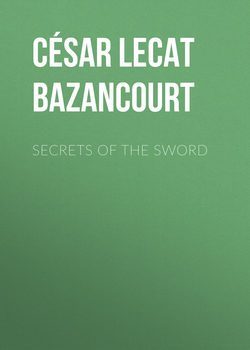Читать книгу Secrets of the Sword - César Lecat de Bazancourt - Страница 16
The Second Evening
V
Оглавление“In like manner the faculty of control is a thing that may be gradually acquired by practice. It is the result of imparting a supple ‘temper’ to the wrist and body, and consists in the knitting up of the various operations into one continuous movement. But, as in the case of fencing judgment, so here, the desired result cannot be obtained all at once. It is the first and most natural consequence of your master’s instructions. It comes of daily practice and you must patiently watch and wait for it, as you might wait for a peach slowly ripening on a sunny wall. Let it grow upon you like a habit, by slow degrees, till it becomes a second nature.
“Speed, not of course mere quickness of hand, but the rapid execution of every movement, is one of the fencer’s great resources, whether in attack, parry, or retreat. It is to my mind the main point to be insisted on from the very first.
“And, accordingly, I think that the master should be careful not to overdo the sort of teaching, that consists in delivering a running commentary such as this: – ‘Steady now: not too fast: take your time about it: think what you are doing: keep your hand in order: mark each motion: at the word one, – and so forth: don’t hurry, you will go fast enough by and by.’
“It is certainly useful to practise the hand by exercising it on the master’s jacket, but it is useless to practise it by slow movements. First explain how the stroke is to be executed, and then without more ado make your pupil get into the way of taking it quickly. Slowness is convenient, because it renders execution easy, but the ease of execution that is derived from it is dangerous, because it reacts on the judgment and accustoms the mind to lazy ways. Your object is, no doubt, to bring the hand under control and analyse the stroke in detail, but if the result of your teaching is that your pupil falls into a sluggish habit you are sowing the seeds of a vice, which you will probably never succeed in extirpating.
“Suppose you are teaching a child to walk, you are not surprised that his first steps are wavering and unsteady, and that he cannot plant his feeble feet firmly on the ground. You hold him up, but you let him walk. In due time he learns to use his strength, as a bird learns to fly. The young fencer is the child learning to walk. As his knowledge and experience gradually expand, many faults will disappear of themselves, or will be more easily seen and corrected by his maturer judgment.
“Speed is a mechanical force, unreasoning, unconscious, but a force capable of development. You must add fuel to the fire and not allow it to go out. Do you suppose that all you have to do is to change the word of command: – ‘Now do quickly what you have done slowly hitherto’? Your new command introduces a new idea and creates new difficulties.
“Such, speaking generally, are the essential principles of fencing. I cannot say whether I have succeeded in showing you clearly how simple the lesson on these lines may be made, or how far I have been able to reassure those, who have inadvertently opened a treatise on sword-play and have fought shy of the subject ever since, but I am convinced that a course of instruction such as I suggest would produce very good results.
“To explain myself more fully, as I am talking among friends and there are no professors present, I will go on to tell you briefly how I should set about teaching the use of the sword.
